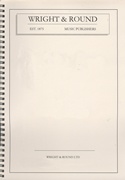We've found 620 matches for your search. Order by
Results
-
 £40.00
£40.00 -
 £40.00
£40.00 -
 £40.00
£40.00 -
 £40.00
£40.00 -
 £40.00
£40.00 -
 £40.00
£40.00 -
 £40.00
£40.00 -
 £40.00
£40.00 -
 £40.00
£40.00 -
 £40.00
£40.00The Nutcracker 'Sweet' (Brass Band - Score and Parts) - Miller, Glenn - Freeh, Mark
The Tchaikovsky Classic a la big band!Tchaikovsky's ballet, The Nutcracker, is a fairy-ballet in two acts, three tableaux and was composed in 1891/2. It is based on The Nutcracker and the Mouse King, a story by E.T.A. Hoffmann (1816). Mark Freeh has arranged this Tchaikovsky classic for brass band.Suitable for Advanced Youth/3rd Section Bands and aboveDuration: 12.00
Estimated dispatch 7-14 working days
